How to Implement Time Sensitive Networking to Ensure Deterministic Communication
Contributed By DigiKey's North American Editors
2022-12-09
Deterministic communication is vital in various applications such as autonomous robotics and other Industry 4.0 systems, 5G communications, automotive advanced driver assistance systems (ADAS), and real-time streaming services. The IEEE 802 Ethernet standards, called Time Sensitive Networking (TSN), have been expanded to support deterministic communication. Properly implemented, TSN can be interoperable with non-TSN devices, but deterministic communication is only available between TSN-enabled devices. There are numerous IEEE 802 standards to coordinate when implementing TSN and ensure that it delivers both deterministic communication and interoperability, making it complex and time-consuming to design TSN into networking equipment from scratch.
Instead, designers of networking equipment can turn to microprocessor units (MPUs) with built-in TSN functionality to speed time to market and reduce development risks. This article reviews the basics of TSN operation and implementation, introduces some of the many IEEE 802.1 standards for implementing TSN, considers how IEC/IEEE 60802 relates to TSN, and compares TSN with other protocols like EtherCAT, ProfiNet, and EtherNet/IP. It then presents MPUs from Texas Instruments, NXP, and Renesas that include TSN capability, along with development platforms that support the integration of deterministic networking into Industry 4.0 devices.
Prior to the development of TSN, real-time networking was only available on specialized industrial field buses. Field buses are often referred to as the ‘industrial Ethernet”. The 802.1 TSN standards define layer-2 functions and local area networking (LAN) level switching and add the concepts of time and synchronization. TSN does not replace protocols at levels above layer-2 and does not define the software interface or hardware configurations and features, making it compatible with various application programming interfaces (APIs) (Figure 1).
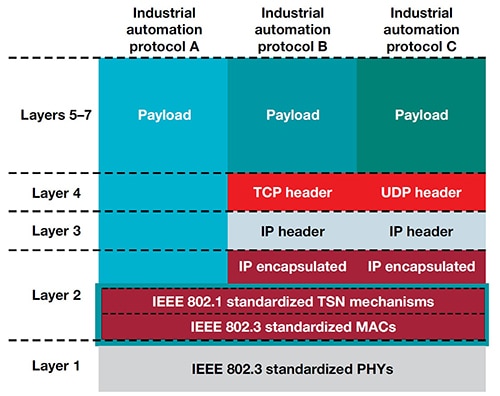 Figure 1: TSN standards define layer 2 functions and can coexist with various APIs. (Image source: Texas Instruments)
Figure 1: TSN standards define layer 2 functions and can coexist with various APIs. (Image source: Texas Instruments)
Existing TSN traffic shaping algorithms enable the co-existence of real-time traffic with regular best-effort traffic within standard Ethernet networks. Determinism and low latency can be guaranteed for time-critical communication. That can support the deployment of safety-related systems in industrial and automotive environments. Some of the key IEEE 802.1 TSN sub-standards include (Table 1):
- IEEE 802.1 AS – timing & synchronization
- IEEE 802.1Qbv – time-aware shaper
- IEEE 802.3Qbr – interspersed express traffic
- IEEE 802.1Qbu – frame preemption
- IEEE 802.1Qca – path control & reservation
- IEEE 802.1CB – redundancy
- IEEE 802.1 Qcc – enhancements and improvements for stream reservation
- IEEE 802.1 Qch – cyclic queuing & forwarding
- IEEE 802.1Qci – per-stream filtering and policing
- IEEE 802.1CM – time-sensitive network for fronthaul
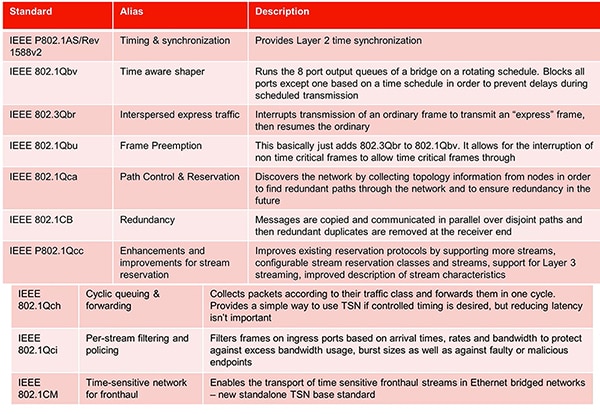 Table 1: TSN relies on numerous sub-standards to provide deterministic performance, redundancy, and other features in a modular fashion. (Image: Texas Instruments)
Table 1: TSN relies on numerous sub-standards to provide deterministic performance, redundancy, and other features in a modular fashion. (Image: Texas Instruments)
IEEE TSN can be partitioned into four categories of sub-standards that are required to ensure the operation of TSN. Time synchronization is the bedrock to ensure the synchronization of clocks across a network. 802.1AS, also called 802.1ASrev, is the primary sub-standard related to synchronization.
Another group of sub-standards relates to bounded low latency. Support for bounded low latency is a necessary condition for achieving determinism in data transmissions and is defined with five sub-standards: 802.1Qat (credit-based shaper), 802.3Qbr (interspersed express traffic), 802.1Qbu (frame preemption), 802.1Qbv (time aware shaper (TAS)), 802.1Qav (cyclic queuing and forwarding), and 802.1Qcr (asynchronous traffic shaping).
Ultra-reliability is required to deal with faults, errors, and provide redundancy and related functions. Related sub-standards include: 802.1CB (frame replication and elimination), 802.1Qca (path control and reservation), 802.1qci (per-stream filtering and policing), and parts of 802.1AS and 802.1AVB (reliability for time synchronization from the timing and synchronization parts of TSN and the IEEE audio bridging standard).
There is a group of general sub-standards related to dedicated resources, APIs, and other necessary “overhead” features including higher level planning and configuration and interoperability in heterogeneous networks. Examples of these general sub-standards include: 802.1Qat (stream reservation protocol), P802.1Acc (TSN configuration), compatibility with YANG (Yet Another Next Generation) data modeling language, and 802.1Qdd (resource allocation protocol).
The modular design of TSN enables it to be optimized for specific applications and use cases. Not every feature is needed every time. For example, 802.1AS, timing and synchronization are especially important in all factory automation uses of TSN while redundancy may be required by only a subset of automation use cases.
How does IEC/IEEE 60802 relate to TSN?
At the time of this writing, the IEC/IEEE 60802, Draft 1.4, TSN Profile for Industrial Automation is out for comment and is expected to be approved sometime in 2023. This IEC SC65C/WG18 and IEEE 802 project will define TSN profiles for industrial automation. This joint effort will include profile select features, options, configurations, defaults, protocols, and procedures of bridges, end stations, and LANs to build industrial automation networks. Like the existing IEEE 802 TSN standards, 60802 will be flexible and modular and address a range of networking scenarios.
IEC/IEEE 60802 will go beyond the IEEE 802 standards and is being developed in recognition of the fact that users and vendors of interoperable bridged time-sensitive networks for industrial automation need guidelines for the selection and the use of TSN related standards and features in order to effectively deploy converged networks that simultaneously support operations technology traffic and other traffic. The release of the IEC/IEEE 60802 TSN Profile for Industrial Automation could prove to be a source of confusion, at least initially, since various field buses are often referred to as the “industrial Ethernet”.
TSN and field buses
The use of TSN and field buses is not an either-or proposition. They are compatible, often used together and all employ concepts related to time synchronization. Yet field buses like PROFINET, EtherNet/IP, and EtherCAT, implement synchronization in different ways. PROFINET uses the precision time control protocol (PTCP). EtherCAT uses distributed clocks that employ dedicated and associated registers for synchronization.
PROFINET and EtherNet/IP include the IEEE Ethernet learning bridge as the underlying switching technology. As a result, these protocols can now adapt the extension of TAS and frame preemption to use standard TSN hardware. EtherNet/IP uses UDP packets for data exchange and is compatible with the TSN switching layer. PROFINET supports a direct layer-2 buffer model for data supported by the programmable real-time unit industrial communications subsystem (PRU-ICSS) TSN solution.
TSN is designed to support cycle times at least as low as EtherCAT and PROFINET and other industrial Ethernet protocols. When upgraded to Gigabit Ethernet, TSN is expected to exceed the performance of the other protocols. Support for deterministic traffic in EtherCAT is limited to special types of data packets. Using EtherCAT and TSN in combination can improve flexibility. For example, around synchronization, TSN adds multi-master capabilities. All three protocols provide redundancy in different ways. TSN uses a technique like the parallel redundancy protocol (PRP) and the high-availability seamless redundancy (HSR) protocol as defined in IEC 62439-3 implement zero-loss redundancy (Table 2).
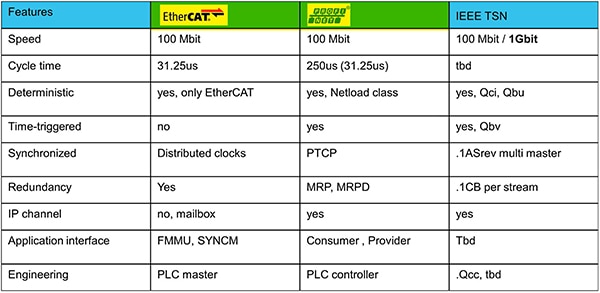 Table 2: EtherCAT, PROFINET and TSN have similar features, but implement them in different ways. (Image source: Texas Instruments)
Table 2: EtherCAT, PROFINET and TSN have similar features, but implement them in different ways. (Image source: Texas Instruments)
TSN does not include an application layer and does not challenge field buses at the application level. For example, interconnecting machines with switches while still using EtherCAT at the machine level can create an industrial Ethernet network that includes TSN functions. A TSN-EtherCAT integrated network does not mix the technologies but defines a seamless integration to use both technologies and realize the best performance aspects of each one.
MCU with up to 6 TSN ports
Designers of Industry 4.0 embedded devices that need TSN connectivity can turn to the AM652x Sitara processors from Texas Instruments like the AM6528BACDXEA. These MCUs combine two Arm Cortex-A53 cores with a dual Cortex-R5F and three programmable real-time unit and industrial communication subsystem Gigabit (PRU_ICSSG) subsystems that can be used to provide up to six ports of industrial Ethernet including TSN, PROFINET, EtherCAT, and other protocols, or they can be used for standard Gigabit Ethernet connectivity (Figure 2).
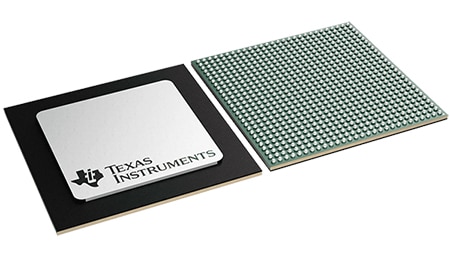 Figure 2: The AM652x Sitara processors include six ports that can be used for TSN and other industrial Ethernet protocols. (Image source: Texas Instruments)
Figure 2: The AM652x Sitara processors include six ports that can be used for TSN and other industrial Ethernet protocols. (Image source: Texas Instruments)
The AM652x family of MCUs includes secure boot and cryptographic acceleration in addition to granular firewalls managed by the device management and security control (DMSC) subsystem. Additionally, the dual Cortex-R5F MCU subsystem is available for general purpose use as two individual cores, or the cores can be used in lockstep for functional safety applications.
MCU with CC-Link IE TSN stack
NXP’s i.MX RT1170 crossover MCUs, like the MIMXRT1176DVMAA, have a dual-core architecture with a high-performance Cortex-M7 core (running up to 1 GHz) and a power-efficient Cortex-M4 core (running up to 400 MHz). This dual-core architecture helps enable applications to run in parallel and supports power consumption optimization by turning off individual cores as necessary. These MCUs deliver a full CC-Link IE TSN communication stack and are optimized to support real-time operations and deliver a 12 ns interrupt response time.
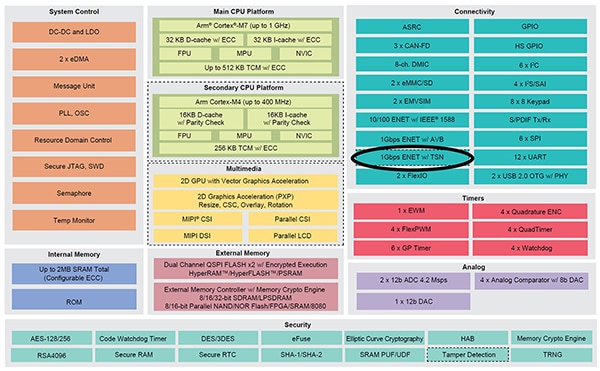 Figure 3: The i.MX RT1170 MCUs from NXP include a dedicated TSN functional block (inside the black oval). (Image source: NXP)
Figure 3: The i.MX RT1170 MCUs from NXP include a dedicated TSN functional block (inside the black oval). (Image source: NXP)
To speed the development of machine learning (ML) applications, real-time motor control, advanced human machine interfaces (HMI) like facial recognition, and other Industry 4.0 applications, NXP offers the MIMXRT1170-EVK evaluation kit (Figure 4). This eval kit is built on a 6-layer printed circuit board (PCB) with through hole design for better electromagnetic compatibility (EMC) performance and it includes two Ethernet ports for development of TSN connectivity.
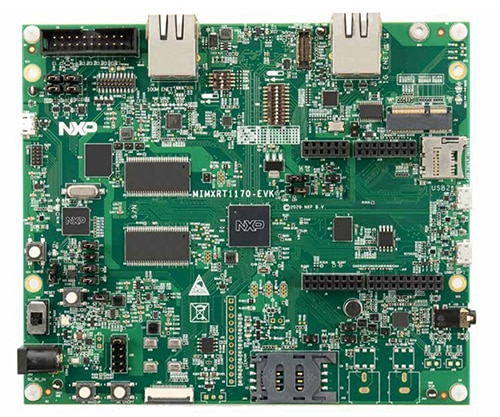 Figure 4: NXP’s MIMXRT1170-EVK evaluation kit. (Image source: NXP)
Figure 4: NXP’s MIMXRT1170-EVK evaluation kit. (Image source: NXP)
MCU and starter kit for TSN
The RZ/N2L family of MCUs, like the R9A07G084M04GBG#AC0, from Renesas are designed to simplify the implementation of industrial Ethernet and TSN in Industry 4.0 applications. They enable deterministic communications through a 3-port Gigabit Ethernet switch that supports TSN, EtherCAT, PROFINET, EtherNet/IP, and OPC UA. Renesas also offers the RTK9RZN2L0S00000BE Starter Kit+ for RZ/N2L MCUs. This starter kit includes extensive peripheral functions suitable for industrial applications and supports the evaluation of industrial Ethernet and TSN (Figure 7). The kit includes all the needed hardware and software:
- Hardware
- CPU board with RZ/N2L MCU and on-board emulator
- Power supply USB cable (Type C to Type C)
- On-board emulator connection USB cable (Type A to Type Micro B)
- PC terminal debugging USB cable (Type A to Type Mini B)
- Software
- The development environment, sample code, and application notes are available on the web which also includes a software support package with peripheral drivers and numerous application examples for rapid evaluation and prototyping.
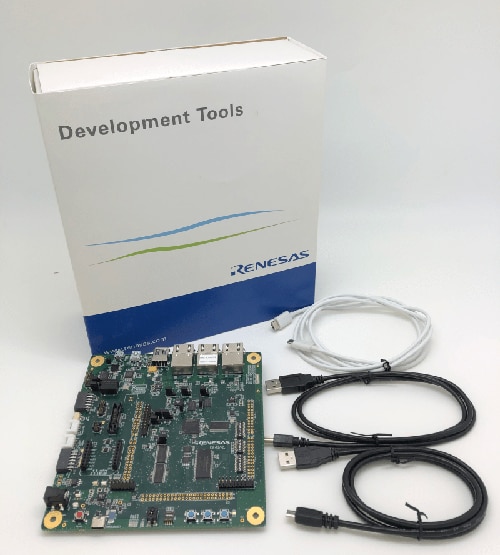 Figure 5: The RTK9RZN2L0S00000BE Starter Kit+ includes the necessary hardware and software, plus application examples, to support development of deterministic networking. (Image source: Renesas)
Figure 5: The RTK9RZN2L0S00000BE Starter Kit+ includes the necessary hardware and software, plus application examples, to support development of deterministic networking. (Image source: Renesas)
Summary
TSN has been added to the IEEE 802.1 Ethernet standards to support the development of deterministic communications. TSN defines layer-2 communications functions and is compatible with higher level protocols such as EtherCAT, PROFINET, EtherNet/IP, and others. It will soon be embodied in an international standard, IEC/IEEE 60802, TSN Profile for Industrial Automation. Suppliers have already begun integrating TSN into MCUs and related development platforms to help designers rapidly integrate deterministic communications into the next generation of Industry 4.0 devices.

Disclaimer: The opinions, beliefs, and viewpoints expressed by the various authors and/or forum participants on this website do not necessarily reflect the opinions, beliefs, and viewpoints of DigiKey or official policies of DigiKey.







